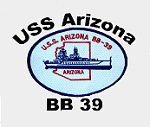Warships of World War II WS00001 US Navy Pennsylvania Class Battleship - USS Arizona (BB-39), 1915 (1:1250 Scale)
"Wherein the structure sags in the center but stands strong and vigorous at the ends, expresses initial defeat and ultimate victory ... The overall effect is one of serenity. Overtones of sadness have been omitted to permit the individual to contemplate his own personal responses ... his innermost feelings."
- Architect Albert Preis discussing the architecture of the USS Arizona Memorial, Pearl Harbor, Hawaii
 The Pennsylvania-class battleships, of the United States Navy, were an enlargement of the Nevada class; having two additional 14 in (356 mm) 45 caliber main battery guns, greater length and displacement, four propellers and slightly higher speed. They also had a relatively large secondary battery of 5 in (127 mm) 51 caliber guns, which was soon reduced when many of the guns' locations proved prone to wetness.
The Pennsylvania-class battleships, of the United States Navy, were an enlargement of the Nevada class; having two additional 14 in (356 mm) 45 caliber main battery guns, greater length and displacement, four propellers and slightly higher speed. They also had a relatively large secondary battery of 5 in (127 mm) 51 caliber guns, which was soon reduced when many of the guns' locations proved prone to wetness.
The General Board having just finished the design of the Nevada class battleship moved on towards the 7th class of U.S. dreadnought design issuing the 1913 design parameters, 12 14"/45 main guns, 22, 5"/51 secondary's, 21 knots, and Nevada Class battleship armor. Minor rearranging of the secondary guns into fire control groups was designated. The strength of the General Board was again shown by demanding better ships from C&R Bureau and overcoming stagnation as it had done with the Nevada class battleships. The resulting ship now carried twelve 14"/45 by using triple turrets in all 4 positions that would be carried on in each succeeding class up to the Colorado class battleship when twin 16" turrets would be used.
Pictured here is a 1:1250 scale diecast replica of the US battleship Arizona as it appeared in 1915.
Now in stock!
Dimensions:
Length: 5-1/2-inches
Width: 1-inch
Release Date: February 2022
 Historical Account: "Protecting Pearl" - Japanese aircraft appeared in the skies over Pearl Harbor just before 8:00 am on Sunday morning, December 7th, 1941. The color detail was on deck in anticipation of raising the flag at the stern at 8:00. The Arizona came under attack almost immediately, and at 10 minutes after the hour received a hit by a 800-kilogram bomb just forward of turret two on the starboard side. Within a few seconds the forward powder magazines exploded, gutting the forward part of the ship. The foremast and forward superstructure collapsed forward into the void created by the explosion and turrets one and two, deprived of support, dropped more than 20 feet relative to their normal position. The explosion ignited furious fires in the forward part of the ship.
Historical Account: "Protecting Pearl" - Japanese aircraft appeared in the skies over Pearl Harbor just before 8:00 am on Sunday morning, December 7th, 1941. The color detail was on deck in anticipation of raising the flag at the stern at 8:00. The Arizona came under attack almost immediately, and at 10 minutes after the hour received a hit by a 800-kilogram bomb just forward of turret two on the starboard side. Within a few seconds the forward powder magazines exploded, gutting the forward part of the ship. The foremast and forward superstructure collapsed forward into the void created by the explosion and turrets one and two, deprived of support, dropped more than 20 feet relative to their normal position. The explosion ignited furious fires in the forward part of the ship.
The majority of the crew members were either killed by the explosion and fire or were trapped by the rapid sinking of the ship. Many of the survivors displayed remarkable courage in assisting their shipmates to safety. Lieutenant Commander Samuel G. Fuqua was awarded the Medal of Honor for his role in leading the rescue of other survivors. It was also awarded posthumously to Rear Admiral Isaac Kidd and Captain Franklin Van Valkenburgh. 1,177 of the crew died on the ship.
During the months and years that followed, the destruction of the Arizona came to symbolize the reason the U.S. was fighting the Axis powers in World War II. (courtesy The University of Arizona Library).


